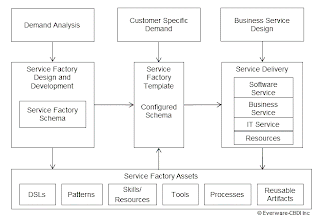In July 1989 the Harvard Business Review published a seminal article by Chase and Garvin titled The Service Factory [1]. They argued that “The factory of the future is not a place where computers, robots, and flexible machines do the drudge work. . . the next generation, then, will compete by bundling services with products, anticipating and responding to a truly comprehensive range of customer needs.”
Since the publication some 25 years ago, much has happened to validate Messrs Chase and Garvin’s thesis. The world has manifestly transformed into a “service based world”. By some accounts the service sector grew to over 80% of the US economy by 2000. There are various implementations of the Service Factory concept; we might observe that the ubiquitous Call Centers represent a scalable, repeatable factory model. Similarly in the technology world services, or APIs, are a central part of many IT architectures, and some firms have adopted a service factory model by separating service and solution delivery.
But it must be said that for most enterprises there remains a significant gap between the business and software services. Over 25 years ago Chase and Garvin recognized this as an issue. They use the example of how 200 years ago horse-drawn carriages were mostly made by craftsmen, and the most successful carriage maker was invariably the most accommodating for the customer. But as mass production overtook craftsmanship customers came to value standardized, lower price more than higher price, personalized products. Gradually manufacturing became separated from pre and post-sale customer facing activities. In recent years in some industry sectors, there has been a noticeable reversal of this trend, and mass customization is widely practiced. However in many industries, notwithstanding Agile methods focus on customer involvement, the design of business services remains a discrete activity from the architecture and design of IT services.
This is starting to change. The Mobile revolution and the Internet of Things will inevitably cause a convergence of business and software services. I have described this as “turning the business inside out”. In future it will be a very rare business service that isn’t delivered by a software service, at least as an option or complement. It’s a racing certainty that Call Centers and other conventional service delivery models are going to go the same way as Telephone Exchanges, Typing Pools and Airline Reservations Departments! In this fast emerging world, “everything is a service”. And this will have a profound impact on the shape of the Service Factory of tomorrow.
The Service Factory 2.0 will be a software factory separate from solution delivery projects. As discussed some firms already employ this organizing model in order to architect and design services to standardize core business information and rules for use in many processes.
The software factory concept has been in use for some time, particularly in conjunction with the Product Line concept, where common components are delivered using a framework of tools, repeatable processes and patterns, that are reused in solutions supporting the Product Line. The Service Factory 2.0 is a specialization of the software factory, with a framework that is specific to services. However the most effective service factory will also be a “business service” delivery model in which the life cycle of the business, software and IT service perspectives are integrated.
We can anticipate a number of critical innovations that will enable the Service Factory 2.0:
1. Everything is a Service All business capabilities are delivered as modular software services which are integral to the holistic business service offering.
2. Automated Requirements Capture. The requirements activity is automated in a manner that facilitates the involvement of the real stakeholders in the specification of the business, software and IT service, in a language that is entirely natural to them and to engage meaningfully in distributed Agile processes.
3. Automation of Common Service Patterns. The Service Factory frameworks that bootstrap service implementations will increasingly automate many of the common architectural and business model styles. Yet unlike the de facto application package products, the Service Factory will facilitate the extension and customization of the common pattern to allow competitive differentiation for the customer organization, as well as ongoing flexibility.
4. Service Portfolio Management. The Service Factory must support the management of the “business service” and provide tools that integrate demand management, architecture and governance over a composable and constantly evolving business and software service portfolio.
6. Pattern R&D. An important role of the service factory will be to continuously evolve patterns to enable and support innovation in styles of business service together with increased scope of automation coverage
7. Architecture Managed Iteration. Pattern based development delivers code that is always compliant with the architecture, but also with meta data that allows full automation of configuration management. This facilitates continuous, low effort iteration in the delivery, test, DevOps cycle and evolution in production.
In their paper, Chase and Garvin quote Drucker who noted that the imperatives of information-based competition are breaking down barriers within businesses and making functional divisions obsolete. To my mind, the primary characteristic of Service Factory 2.0 will be the realization of the business, software and IT service as a composite offering, architected, designed and delivered as a business asset.





